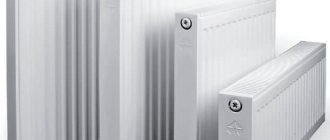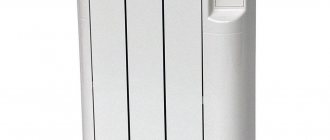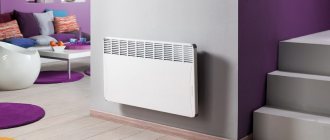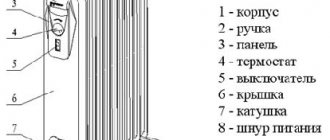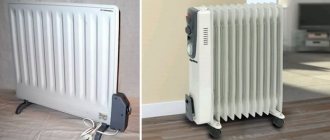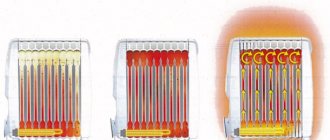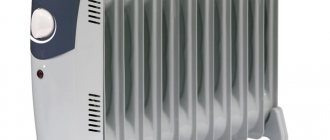Due to interruptions in heating, the temperature in the living space may drop. To raise it, all kinds of heaters are used, including oil heaters with a fairly high efficiency. The latter has a number of advantages, since the operating principle of an oil heater can leave air humidity almost unchanged. The industry produces a wide variety of heaters; they have different characteristics, capabilities and design features. Once you get to know them better, you can choose the right one for your specific living space.
Oil fired heater
Oil heaters (heating radiators)
Externally, an oil-type radiator is similar to a conventional sectional battery that hangs under the windows in apartments and houses. The only difference is the operating principle and the energy carrier - the portable radiator operates from the electrical network, and not from the central heat supply from the boiler room.
Design and principle of operation - how does it work?
The difference between an oil radiator and analogue stationary heating devices is that it operates from the mains. If in conventional batteries there is water inside the sections, then here there is mineral oil. When plugged into the network, such oil boils, heating the walls of the device, which, in turn, heat the room with warm air.
The operation of the equipment is ensured by:
- Thermostat.
- heating element.
- Control panel with plastic knobs and incandescent thermometer.
- A network cable that provides power supply.
The body of the product is made of metal, which is coated on the outside with a special anti-corrosion and anti-shock powder coating. It is this composition that helps to avoid surface damage to the plates with further deformation.
Each section of an oil-type radiator has a hermetic, dense base that does not allow the seams to separate when the oil heats up.
Advantages and disadvantages
Depending on the manufacturer, such a device has certain design features: an autonomous controlled thermostat or a touch control panel. But, in any case, the heating element has a number of advantageous characteristics, including:
- silent operation, no extraneous sounds occur when the oil is heated;
- high level of heat transfer - efficiency;
- long service life without the need for repairs - a guarantee of 5 years or more;
- does not emit chemical or other unpleasant odors when heated;
- Easily transported from room to room thanks to the available wheels;
- does not contribute to dry air.
Among the disadvantages, it is important to note such features as the long period from heating the heating element to the supply of heat to the space, as well as the large weight of the product. However, such disadvantages are relative - weight is not a problem, since there are wheels, and after heating, the temperature lasts longer than when using other heating devices.
Devices with a built-in fan heat the room faster; literally within 1-2 minutes after switching on, the radiator heats the room.
Is it dangerous? Safety precautions
Existing warnings regarding the toxicity of the oil in the radiator are unfounded.
Modern devices have double or triple protection, which, even with a direct impact, does not violate the integrity of the coating.
Hot oil is indeed under pressure inside and is a flammable component. But the degree of protection of the heater is so high that with proper operation for many years no negative aspects will be noted.
Each oil-type radiator has a glow sensor that is activated when heated to 60 degrees. Above this temperature, heating does not occur - the heating element turns off.
Oil-filled heater operation
The operating principle of the oil cooler is as follows. When the device is connected to the electrical network, the device goes into standby mode. To turn it on, you need to select an operating mode; it is selected using an adjustable thermostat.
Other models on the case have two power adjustment keys; when one of them is turned on, the following circuit is connected: power is supplied to the fuse, then the current passes through the heater spiral, indicator light and mode switch contacts. After this, it passes through the closed tip-over protection contacts; if the heater is tilted strongly, these contacts are open and the device will not turn on. Then the current passes through the contacts of the emergency and adjustable thermostat and goes into the network. If you need to increase the heating speed, turn on the second heater coil using another key, which is connected in parallel to the first.
How do thermostats work? As the heating element heats up, the oil around it also begins to heat up and rise, and cold oil comes in its place. This is how the entire volume of coolant is mixed and heated.
Action of heating element
Heat is transferred to the walls of the radiator and then to the surrounding air. The thermostats located in the lid begin to heat up. When the set temperature is reached, the thermostat operates and disconnects the circuit. After the thermocouple has cooled, the contacts close and the heating process continues. For clarity, you can watch this video:
Important! There are ventilated holes on the lid; if you close them, the thermostat will take a very long time to cool down, which will slow down the heating of the room.
The emergency thermostat protects against overheating; it is adjusted at the factory to the maximum temperature. If for any reason the service thermostat does not operate, the circuit will open the emergency device, preventing damage that could be caused to the heater.
It can be returned to its working position by pressing the corresponding button. This design allows the owner to find out if a malfunction has occurred; it must be eliminated before starting to use the device again. If there is no such button, the heater must have an emergency valve. De-energization will also occur if the electric heater is tipped over due to the activation of the tip-over protection.
Classification and main characteristics
There are many oil-type radiators, which differ in the number or presence of additional options - built-in mechanisms, fans or place of operation.
Wall mounted
Models that can be attached to a vertical surface are called wall-mounted. They tend to be flatter and have non-protruding sections that do not interfere with the bracket's ability to catch on the hanging hooks. Often such modifications are universal - they have a place for screwing on wheels, which allows you to install them on the floor in the right place.
Floor-standing
This type is the most common and is popular due to its portability: if it is necessary to heat several rooms, it can be reinstalled with little physical effort.
The heat transfer of such a floor-mounted device is the highest. There is a separate subtype of floor models - baseboard heaters. They are installed in the corner of the wall and floor in place of the baseboard. They have a long and narrow shape.
Tabletop
Modifications that can be placed on a table are small in size and the same weight. They are designed to provide additional heating to a small room. Also used in the form of heating a children's room or crib.
The number of sections for tabletop types is no more than 5; the height of such sections is half that of floor ones.
For cots
Radiators designed for heating children's rooms differ, in most cases, in their appearance and mobility.
These can be either wall or tabletop modifications with bright colors. A significant advantage of using such a heating element is that the air does not dry out, and the humidity during battery operation is at least 60%, which is important for children who are often ill.
Children who often suffer from acute respiratory viral infections or chronic lung diseases - bronchitis, laryngitis, tracheitis - need constant air humidification. Fans that operate on the principle of a hair dryer cannot be used to heat a room - they heat up and move air around the room.
Main selection criteria
Choosing the best heater is a rather difficult task, the solution of which largely depends on the goals that the buyer has set for himself. But there are key criteria that I would like to draw your attention to:
An excellent addition to the room heating function is drying clothes, which can be problematic if the weather is bad outside and the radiators in the house are still cold
No. 1. Technical parameters. The main attention should be paid to the power of the device. This characteristic will be discussed further below. Here it is enough to mention that the power must be interconnected with the size of the room that needs heating.
We need a radiator to create comfort in the house, so preference should be given to a more powerful model. After all, it’s very disappointing when, after purchasing a low-power model, you continue to freeze. A fairly powerful product that has at least 2 heating modes, a temperature controller and a built-in thermostat deserves attention.
No. 2. Section sizes. Geometrically, the parameters of the device also matter. Narrow sections heat up faster, using less electricity for this process, but their total surface area is small. Therefore, heating the air in the room with their help will not happen too quickly.
Wide sections can be quickly cooled by air, so more electricity will be needed to heat them up. By choosing the parameters of the sections, you are essentially making a choice between the speed of heating the room and savings.
No. 3. Weight. Do not buy a device that is too light and has impressive dimensions. This effect can occur if the metal used to make the radiator is too thin or for some reason there is not enough oil in the device.
No. 4. Additional elements. In the off-season, when it’s already cold outside and it’s raining, and you haven’t even thought about turning on the heating, you need to somehow solve the problem of drying clothes. It cannot be placed directly on the heater, as on a regular radiator. But buying a device directly with a dryer is an excellent way out. It is better to ignore unnecessary options.
No. 5. Appearance. Any device must not only perform its assigned functions, but also be pleasing to the eye. If a designer has worked hard on the interior of your country house, it would be a shame to ruin all his efforts by purchasing an item that is discordant with the surrounding space.
Moreover, there is plenty to choose from: stores present to our attention models from different manufacturers, colors, shapes and sizes. There are also neutral products that can fit into almost any interior.
Thanks to relentless competition in the electrical goods market, a variety of heater models are appearing, which allows you to choose a product not only by its functions, but also by color, size and other parameters.
An oil heater is a device that should serve you for many years. When purchasing it, do not forget to correctly fill out all the documents that will allow you to apply for warranty repairs if such a need arises.
Tips and tricks for choosing
Radiators are produced with different power, which, among other things, depends on the number of sections: the more there are, the larger the heating area. The disadvantage of increasing the number of sections is the need to provide more space, which is difficult in small rooms. Although, such parameters for assessing characteristics are individual and this does not affect the mobility of equipment. In general, when purchasing an oil-type heater, pay attention to several features.
Continuous operation of the oil battery – 3 days.
Electricity consumption and the most energy efficient range
The convenience of oil radiators is obvious, but some buyers are confused by the energy consumption of such an installation - how much does the battery use per day? The power of the device is selected according to the size of the heated room. On average, heating 10 sq/m of space requires 1 kW of energy, if it is a living space with ceilings of 2.75-3 m. If the ceilings are higher, the calculation is carried out:
- The area of the room is calculated - the length is multiplied by the width.
- The volume of the room is determined by multiplying the area by the height.
- Divide the resulting number by 25 (because 25 m3 produces 1 kW).
- The result obtained is the heater power we need. If the quantity is very large, then you need to buy several radiators, which in total will provide the required energy
So, according to the above calculations, it turns out that for a room of 20 square meters. m, a 1.5 kW heater is suitable.
Dimensions and appearance (flat, small)
The height of one section is from 580 to 700 mm, width is 362-650 mm. The depth of the section to the central part is 90-290 mm. The number of such sections is 5-12, the most popular models with 9 or 11. They are flat, wide or narrow in shape. The smallest ones are plinth ones, their length is up to 1.5 meters, diameter is 50-90 mm.
The surface temperature differs from the maximum heating of the oil itself. So, if the oil is heated to a temperature of 60 degrees, then the surface of the sections heats up to 95°C.
Control
The control unit for oil convectors is located on the side of its end part. As a rule, this is a plastic panel with switches that control:
- operating modes;
- light indicators;
- humidifiers;
- shutdown sensors when the device overheats;
- duration of operation of the TEN;
- air heating temperature;
- Energy consumption;
- fan operation;
- duration of rest mode during continuous work.
Some modern models have LCD monitors with touch controls even from a distance.
Manufacturer and price - how to choose?
The range of products for heating autonomous rooms is large. Almost any household store has several manufacturers, but according to customer ratings, the most frequently purchased are:
- Vitesse VS-877.
- General Climate.
- Timberk.
- DeLonghi.
- Bimtek.
The price of radiators, depending on the number of sections and the manufacturer (domestic or imported), starts from 3 thousand rubles to 30 (for domestic needs, other amounts for industry).
Types of models
Often their appearance and design depend on the location, namely:
- Floor radiators (the most popular and functional).
- Wall-mounted with flat surfaces (they are economical in terms of energy consumption).
- Desktop low-power devices (having fairly low heat output).
There are models of radiators with a fireplace effect. They can warm up the room silently and quickly enough. This happens because drafts are installed on both sides, so the heated air can circulate much faster.
New models of oil heaters have built-in software blocks with a timer, which makes it possible to set the switch on and warm up the room at a given time. They are usually equipped with a remote control and an emergency sensor that responds to the fall of the device (the device turns off).
Everyone knows that it is not recommended to dry clothes on radiators, as this may cause the device to overheat. But some of their models have special removable frames, which are designed specifically for drying clothes without causing damage to the device.
Conventional heaters are not recommended for heating bathrooms or wet rooms. For this purpose, special baseboard oil heaters are now produced, which are shaped like a narrow panel attached to the baseboard and take up little space. Such devices are quite safe and can be installed even in damp rooms.
We found out that oil heating devices are an imitation of the radiator of a central heating system. For the most part, they do not require special installation and operate from a 220 V network. Their design is a hollow form filled with mineral oil, in which the heating element is located. They are safe and relatively inexpensive.
For industrial purposes or for home: household or industrial
If for domestic needs there are a large number of offers at different prices, then for industry there is a separate line of products that differ in power, size and, accordingly, price. The maximum number of sections of one oil radiator is 14. For industrial premises, it is important not only their required number, but also their correct location. Thus, suspended models heat the air faster, and the power of the device must be at least 2.5 kW.
Guarantee
The warranty period for storage of oil radiators is 1 year, and for use - 2 years.
During the warranty period, the manufacturer guarantees satisfaction of the buyer's requirements related to problems in the operation of the radiator, subject to the rules of operation, transportation and storage of the device.
Warranty obligations are fulfilled only if the fact of purchase is confirmed by a receipt, where the date of purchase is clearly visible.
Warranty obligations are not fulfilled in case of mechanical damage to the device, such as dents, scratches, or other defects.
Installation
Installation of the heater does not require special skills and knowledge. If it is a hanging model, it is mounted on brackets that are pre-installed at the required distance from each other. If the model is mobile on wheels, then all that is needed for installation is to determine the safest place near the outlet. It is worth considering that there should be no obstacles in the heater’s path - curtains, sofas or chests of drawers. It is best to install it in the central part of the room in the first 2-3 hours of operation. After the space has warmed up, it is moved to a more comfortable distance - near a wall or fireplace.
Oil
Transformer oil is a dielectric with excellent thermal conductivity.
It retains its properties at temperatures down to -45 degrees. Produced from oil by distillation, it has slightly different characteristics. For oil batteries, mineral oil is used, which is similar to transformer oil. Filling the radiator with synthetic gear oil will contribute to its noisy operation - it will begin to make noise and rattle due to the fact that the viscosity is lower and the intensity of convective flows is higher.
It is impossible to use a mixture of oils of different origins for radiators due to the interaction of the different additives present, which after heating it is not known how they will behave. The composition may either curdle or precipitate or thicken. Adding the missing oil is done with identical material available in the device.
Instrument design
The body of these heaters is made of metal and consists of hermetically joined sections. They are topped with a special durable powder coating that is not subject to mechanical stress. There is mineral oil inside the structure. Connect to the device:
- Thermostat.
- Heating element (heating element).
- Wires.
- Heating regulator.
- Special overlay panels.
Which is better: oil or convector
When considering the advantages of convectors or oil radiators, it is worth paying attention to such features as power consumption, dimensions and additional functions. If the heater is needed for regular use, then it is better to choose oil models. For periodic use in insufficiently warm rooms, you can buy convectors with a top supply of warm air.
Heating an apartment or house is a task that arises quite often even with centralized heating. This is due to insufficiently warm stationary radiators or poor location of the apartment, damp weather before the heating season or a desire to better warm up the child’s room. In any case, oil batteries will help ensure the desired temperature in residential areas.
Malfunctions
The most common problems with oil radiators are:
- A cracking noise is heard when turned on and during the first 10-15 minutes of operation. If after this time the cracking disappears, it’s okay. It occurs when the oil inside the radiator heats up.
Perhaps drops of water got into it, which causes such a reaction. This is possible if the device was assembled in conditions of high humidity.
- The radiator does not turn on. First, carefully inspect the cord and plug for cracks or creases. If they are not found, try plugging the heater into a different outlet.
If this does not work, then the problem is in the contact, which has come loose. Try to repair the device yourself or send it to a service center, where experienced technicians will solve the problem.
- The device turns on, but does not heat up. At the same time, indicator lights, a fan and other additional devices on the case work.
The cause of such a breakdown is problems with the thermal relay; it cannot be eliminated without special tools. Contact the service center.
- Oil is leaking. Such a breakdown occurs due to a manufacturing defect (poorly sealed seam) or a long period of use of the device.
Over time, the metal at the joints burns out and becomes thinner, which leads to this type of failure. Unfortunately, it is impossible to repair an oil leak either independently or at a service center.
If the breakdown is serious, you should carefully consider the prospect of buying a new radiator, because sometimes repairs cost more than a new device.


